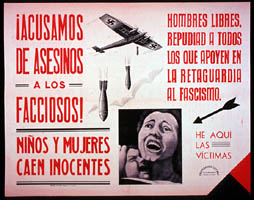 |
¡Acusamos de asesinos a los facciosos! Niños y mujeres caen inocentes. Hombres libres, repudiad a todos los que apoyen en la retaguardia al fascismo. He aquí las víctimas
[We charge the rebels as assassins! Innocent children and women die. Free men, repudiate all those who support Fascism in the rearguard]. . Propaganda editada por la confederación regional de Levante. Ortega, Valencia. Control U.G.T.-C.N.T. Lithograph, 2 colors; 52 x 66 cm.
|
|
Despite the somewhat
amateurish quality of this image in comparison to many Civil War
posters, it is an effective battle cry for action against fascism.
As the red and black colors in the lower right-hand corner indicate,
this poster was issued by the Anarchists. The frightened woman and
child are the victims of the rebels, represented by a Nazi plane
that is dropping bombs on Spain's eastern coast. The portrayal of
woman as victim seems to have been a powerful way of garnering support
in war-time propaganda (also see posters 17, 18, 39). By depicting
women as mothers and spouses threatened by war, artists emphasized
the menace that the rebels presented to the most basic unit of Spanish
society. While this is the only kind of representation of women
to be found in the posters of this collection, there are numerous
examples of propaganda where women are portrayed in more active
wartime roles, as brave militiawomen headed into battle or as workers
on the home front, for example. More negatively, posters warned
soldiers about female prostitutes who spread venereal disease or
about gossipy women who would inevitably reveal important secrets
about the war.
As the variety of representations
of women in Civil War posters demonstrates, the role of women in
the war was not clear. On the one hand, the actions of women in
the war era posed a significant challenge to their traditional role
as guardians of the home. For example, the very prominent Mujeres
Antifascistas, a coalition of women from a variety of leftist
political groups, was formed with the mission of removing the Spanish
woman from the state of ignorance to which patriarchal society had
relegated her. In addition, in the first months of the war, Republican
militiawomen were a common sight in Spain. Women like Lina Odena,
Aida de la Fuente, and Rosario Sánchez fought valiantly in
the war and became part of popular Republican mythology. Women were
also essential as industrial and agricultural laborers, replacing
men who had gone to fight in the war.
On the other hand, the
access to new roles did not necessarily mean fundamental changes
in perceptions about women. Even within a radical group like Mujeres
Antifascistas, there was a split between those who thought women
should be fighting at the front and those who believed they should
concentrate their efforts on the home front. In addition, milicianas,
whose numbers dropped drastically by early 1937, often found themselves
cooking, cleaning and doing laundry rather than fighting in combat.
Manuela, a militiawoman who quickly grew tired of her secondary
role, wrote to the female commander Mika Etchebéhäre
in the hopes of transferring to her command: "I have heard
that in your column the milicianas have the same rights as the men,
that they do not wash the clothes and the dishes. I have not come
to the front in order to die for the revolution with a kitchen cloth
in my hand." The triumph of Franco's forces spelled the end
of increased liberation and the reconfirmation of women's traditional
roles as wife and mother.
|




